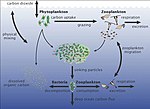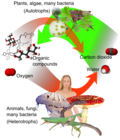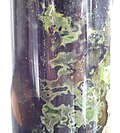A mixotroph is an organism that can use a mix of different sources of energy and carbon, instead of having a single trophic mode on the continuum from... 18 KB (1,679 words) - 13:14, 5 January 2024 |
 | Zooplankton (section Mixotrophs) microplankton have indicated over half of microscopic plankton are mixotrophs. A mixotroph is an organism that can behave sometimes as though it were a plant... 76 KB (7,030 words) - 05:39, 28 April 2024 |
 | Marine microorganisms (redirect from Marine mixotroph) It is estimated that mixotrophs comprise more than half of all microscopic plankton. There are two types of eukaryotic mixotrophs: those with their own... 232 KB (21,384 words) - 06:01, 14 April 2024 |
 | Euglena viridis is a freshwater, single cell, mixotroph microalgae bearing a secondary chloroplast. Their chloroplast is bounded by three layers of membrane... 7 KB (735 words) - 17:27, 12 April 2024 |
 | "Microbiology of thiobacilli and other sulphur-oxidizing autotrophs, mixotrophs and heterotrophs". Philosophical Transactions of the Royal Society of... 98 KB (10,951 words) - 01:31, 5 May 2024 |
Primary nutritional groups (section Mixotrophs) Primary nutritional groups are groups of organisms, divided in relation to the nutrition mode according to the sources of energy and carbon, needed for... 19 KB (1,616 words) - 12:21, 22 January 2024 |
 | be compatible not only with being an autotroph but also with life as a mixotroph or heterotroph. Weiss et al. 2018 reply that no enzyme defines a trophic... 61 KB (6,493 words) - 01:27, 20 March 2024 |
hemidystrophy, heterotroph, hypertrophy, lithoautotroph, lithotroph, mixotroph, organotroph, phagotrophy, photoheterotroph, phototroph, phototrophic... 2 KB (1,764 words) - 06:15, 16 April 2024 |
 | it matures within a host's red blood cell. Protozoa may also live as mixotrophs, combining a heterotrophic diet with some form of autotrophy. Some protozoa... 52 KB (5,202 words) - 14:22, 5 May 2024 |
 | Autotrophs Chemosynthesis Chemotrophs Foundation species Kinetotrophs Mixotrophs Myco-heterotrophy Mycotroph Organotrophs Photoheterotrophs Photosynthesis... 126 KB (12,983 words) - 18:49, 6 May 2024 |
 | are photosynthetically active, but are also heterotrophic. Facultative mixotrophs, in which autotrophy or heterotrophy is sufficient for nutrition, are... 95 KB (10,290 words) - 18:10, 1 May 2024 |
 | to the bed of the water body to overwinter as a turion. The plant is a mixotroph which can produce its own energy by photosynthesis or absorb it from the... 7 KB (814 words) - 09:51, 1 May 2024 |
 | Marine protists (section Mixotrophs) up" in dead organisms. Mixotrophic radiolarians Mixotrophs have no single trophic mode. A mixotroph is an organism that can use a mix of different sources... 131 KB (10,542 words) - 04:29, 6 January 2024 |
 | algae, Cymbomonas tetramitiformis in the order Pyramimonadales, is a mixotroph and able to support itself through both phagotrophy and phototrophy. It... 41 KB (4,066 words) - 15:46, 15 April 2024 |
 | nutrients from the carbon of inorganic substances like carbon dioxide. Mixotrophs are organisms that can be heterotrophs and autotrophs, including some... 36 KB (4,008 words) - 14:34, 6 May 2024 |
carbon dioxide from the air as a carbon source, the same way plants do. Mixotrophs will take up and use organic material to complement their carbon dioxide... 31 KB (2,883 words) - 05:06, 3 May 2024 |













